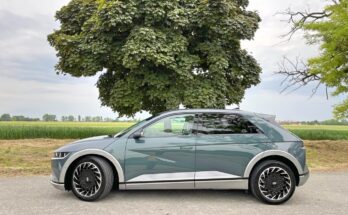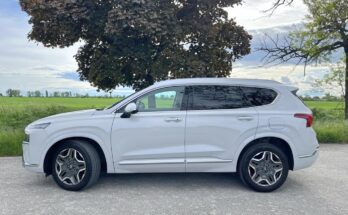Hyundai Ioniq in its current version has been on the market since 2015. It has undergone several small improvements and is currently receiving a successor in the form of the second generation, which is already sold in our country. However, we will take a closer look at the currently ending generation. The price of most electric cars sold in Slovakia today starts at 30,000 euros, and the Hyundai Ioniq is no exception. However, according to our experience, it is the first such electric car in which you feel that you have paid for something extra. The Hyundai Ioniq is sold as an electric car and also as a plug-in hybrid . We were the first to try an electric car, i.e. the Hyundai Ioniq Electric in PLUS equipment – that is, with everything that can be ordered from the price list.

The Hyundai Ioniq Electric has batteries with a (usable) capacity of 28 kWh and quite important thermal management (which, for example, the first generations of the Nissan Leaf lacked) – an integrated heating system heats the high-voltage battery to increase its charging capacity and range at low temperatures. The battery is placed under the rear seats and under the luggage compartment floor for better weight distribution and improved driving characteristics.

The drive system combines a high-voltage lithium-ion polymer battery with high energy density, a powerful electric motor with an output of 88 kW (120 hp) and a maximum torque of 295 Nm, and an efficient single-stage reduction gearbox. Acceleration from 0-100 km/h will give the Ioniq in a great 10.2 seconds. The warranty for the drive unit, steering, suspension and braking system is 5 years, and the warranty for the battery is 8 years or 200,000 km. The consumption is written at 10.5 kWh / 100 km, and you can recharge with the on-board 6.6 kWh charger (extra charge DC Combo2 can up to 100 kW). The paper range is 280 km. So much technical data… let's get down to business.
When I first met the car, I was pleasantly surprised by its dimensions. The design evokes modest driving, but the Ioniq is an adult, full-fledged car for five people. No city mini or small hatchback. The dimensions are a respectable 4470/1820/1450 mm, which puts it at the level of the middle class. In the interior, there is plenty of space in the front and back. Four adults will ride in the car without any problems and will not suffer from space in any direction. Hyundai Ioniq Electric offers a luggage compartment with a volume of 350 liters up to 1410 liters after folding the rear seats. So there is simply no need for space.

Immediately after sitting behind the wheel of the test vehicle for the first time, it was clear that I was in for a pleasant week here. An electrically controlled driver's seat with automatic removal, a clear dashboard and an equally well-crafted center console with a responsive touch screen and sophisticated navigation, or high-quality processing with selected materials. Accessories and aesthetic elements in copper design, which can be found throughout the vehicle. In the extra-charged version, we also find heating of all seats and steering wheel heating.

The connection of navigation and on-board instruments is very good. Right above the current remaining range, for example, you can see the distance left to your destination. Ioniq can also connect to Wi-Fi and function as a Wi-Fi hotspot. In the infotainment system, you can come across all sorts of interesting overviews and settings and it is worth going through it properly. For example, you can graphically display how much is consumed by the electric drive, air conditioning and other electronics or look at an overview of individual routes and their average consumption. It goes without saying that there is seamless support for AndroidAuto and Apple CarPlay.

During the week, I drove the electric car for about 1000 km, where roughly a third was driving on the highway at speeds of around 130 km/h, a third was on district roads and a third was purely city traffic. Consumption during the entire test was at the level of 13.6 kWh / 100 km. When I charged the car with the last 4% of the battery at home from a regular 230V socket with the supplied cable (charges with a maximum power of 2.2 kW), the car took approx. 30 kWh. Charging is really slow in this case and expect to charge all night (7-9 hours for full capacity). The advantage is that you can program the heating of the interior, the defrosting of the windows, and in the morning when the neighbor is scraping the ice with the diesel engine running, you get into a warm car ready to go. Of course, after your hands get a little cold from the ritual of disconnecting the cable.

When recharging via Combo2, I waited about half an hour with the car discharged to 12% to charge up to 90%. The Hyundai Ioniq Electric is said to be able to handle up to 100 kW, but you would be looking for chargers here like a needle in a haystack. When charging at night, you will appreciate such details as the illuminated connector and backlit handles, or the indication of the state of charge of the batteries using three large blue lights on the dashboard under the windshield.
On our tank road trips, I drove most of the time in ECO mode, when the Ioniq reacts very lukewarm to the gas pedal and does not allow the maximum speed to exceed 110 km/h (of course, if you need a sharp acceleration, just press the pedal to the floor and the limitation is turned off). In this mode, the ride is amazingly comfortable and smooth. All you hear is the noise of the tires rolling. However, in the SPORT mode, the real fun begins and the 295 Nm of torque available throughout the range is very addictive. The engine power is thus abundantly sufficient for normal operation and almost nothing in the city has a chance at traffic lights. Any increase in performance would be manifested by spinning wheels, where the main cause is the battery located in the trunk and the front axle drive.

120 horses does not promise a very sporty experience, but the fact that you have them available practically all the time is something that no gasoline or diesel car can provide. When overtaking, you don't have to worry about anything – just step on the pedal and the Ioniq will shoot forward at any speed – unfortunately, the appetite grows with the appetite, and during sporty driving, the range and battery capacity will decrease very quickly. The ability to freely regulate recuperation in four levels from 0 (off) to 3 (strong recuperation) using the paddles under the steering wheel is excellent, and you can actually learn to drive without using the brake pedal. In terms of chassis, the Ioniq is tuned very pleasantly softly and most importantly – it does not bang anything anywhere. Be it transverse bumps, pits, retarders or a dirt road. There is exemplary silence in the interior.

What froze me a little was the bad rear view, where they simply introduce a design spoiler in the middle of the trunk window. However, reversing with the Ioniq is easy thanks to a good camera system. As for assistance systems, Lane Assist can only handle small turning radii and can only work with good visibility on both longitudinal lines on the road. It only manages about 7 seconds, which is enough to open a bottle of drink (of course, it's not designed for that, right…).
The adaptive cruise control is easy to use, and its wide adjustment of the distance from the vehicle in front is more than sufficient for all situations. It can even start from a complete stop by itself, just tap the pedal. The whole morning journey (torture!?) along the D1 to Bratislava, the car "drove" itself. LED headlights have excellent efficiency, but accurate illumination without scattering limits them a bit for urban use. At speeds above 70 km/h, it is necessary to use the main beam headlights, but they shine quite a bit and directly in the middle, so even in a small corner you go a bit blindly + they cannot be set by the user.

As for actually living with an electric car of this category – you have to become a planner. In the morning, you disconnect the charger and you have to calculate where you will get to today. Then an unexpected event comes when you have to run an extra 50 km and the wife is already unlucky in the evening and the candles will be lit on fossil fuels, because in that village in the south they haven't even dreamed of a quick charger yet and you wouldn't be able to get back.

Today's electric cars are still not for long distances, and if you refuse to stand on the charger every 150 km, even if it only takes 30 minutes – it's not for you. An ordinary driver who drives approx. 12,000 km per year and travels a maximum to the regional city (20-50 km) or once in a while to grandma's (150 km), takes the children to school, goes shopping and to work, the one trip a year to Croatia will be in a borrowed car or by plane. For him, charging at home will be the alpha and omega, so it is useless for him to decide how fast the car charges. Apartment owners in blocks of flats without access to an external outlet in the parking lot are also out of the game for now. I myself am a fan of electromobility, but here in Slovakia, living comfortably with an electric car is still a utopia.
However, who is now deciding what he will drive (perhaps rather than the second car in the family) for the next 5 years, does not care about how we treat the environment and can tolerate minor hardships during the commute a few times a year, I can warmly recommend the Ioniq. You can travel over 200 km on one charge without any problems, heating, air conditioning and a heat pump will take care of your comfort in winter and summer with low energy consumption and there is enough space in the vehicle for any average family. Hyundai is currently offering current Ioniq models with significant discounts, and it can be even more advantageous with state subsidies…
| Technical specifications | Hyundai IONIQ Electric |
| Batteries (usable capacity) | 28 kWh |
| Max. speed | 165 km/h |
| Max. power | 120 hp / 295 Nm |
| Acceleration 0-100 km / h | 10.2 seconds |
| Warranty (drive unit, steering, suspension and brake system) | 5 years |
| Battery warranty | 8 years or 200,000 km |
| Consumption | 11.5 kWh / 100 km |
| Charging | onboard 6.6 kWh, DC Combo2 up to 100 kW |
[rl_gallery id=”7470″]




